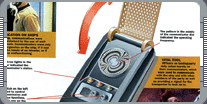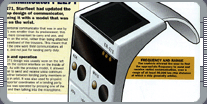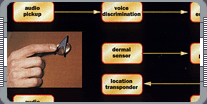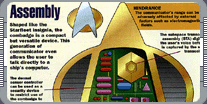
Personal Communicators
Personal communicators are worn by all Starfleet crew members and perform many important functions,
including planet-to-ship transmissions.
 During the 23rd century, communicators were separate devices before being intergrated into the Starfleet
insignia worn on the left side of crew members' uniforms. In the 2260s the communicator was an oblong black
box that was small enough to fit in the palm of one hand. It was constructed of three parts: the upper body
shell, the lower body shell, and the antenna. The upper and lower halves of the black box were separated by
a lighter colored narrow metal strip. In either century, the communicator is an indispensable piece of basic
equipment, and is worn at all times.
During the 23rd century, communicators were separate devices before being intergrated into the Starfleet
insignia worn on the left side of crew members' uniforms. In the 2260s the communicator was an oblong black
box that was small enough to fit in the palm of one hand. It was constructed of three parts: the upper body
shell, the lower body shell, and the antenna. The upper and lower halves of the black box were separated by
a lighter colored narrow metal strip. In either century, the communicator is an indispensable piece of basic
equipment, and is worn at all times.
 Eariler generations of communicators used a gold-colored antenna lattice that was built into the upper body
shell via a single hinge. When the antenna was raised, the communicator made an audible signal to indicate
it was ready to use. Under the antenna was the speaker/microphone, two control switches, three status lights,
and a vent. A transmit/receive switch was on the left, and a channel selector on the right. Communicator
status was shown by three lights set in a line between the speaker/microphone and the switches. The red
light indicated the equipment was active was positioned in the center. The yellow transmit light was on the
left, and the blue receive light was on the right. During the 2270s communicators were smaller and worn on
the wrist. The control interface was on the inside of the arm side.
Eariler generations of communicators used a gold-colored antenna lattice that was built into the upper body
shell via a single hinge. When the antenna was raised, the communicator made an audible signal to indicate
it was ready to use. Under the antenna was the speaker/microphone, two control switches, three status lights,
and a vent. A transmit/receive switch was on the left, and a channel selector on the right. Communicator
status was shown by three lights set in a line between the speaker/microphone and the switches. The red
light indicated the equipment was active was positioned in the center. The yellow transmit light was on the
left, and the blue receive light was on the right. During the 2270s communicators were smaller and worn on
the wrist. The control interface was on the inside of the arm side.
The modern communicator is made of a crystalline composite of silicon, beryllium, carbon 70, and gold, and
has a protective casing made of micromilled duranium coasted with gold and silver alloys. For aesthetic
 purposes, it is fashioned in the shape of the Starfleet emblem. Underneath the duranium casing there is a
set of complex components powered by a sarium krellide crystal that supplies enough power for two weeks' use.
When the crystal is almost exhausted it produces an audible oscillation, and power can be restored by
induction recharging.
purposes, it is fashioned in the shape of the Starfleet emblem. Underneath the duranium casing there is a
set of complex components powered by a sarium krellide crystal that supplies enough power for two weeks' use.
When the crystal is almost exhausted it produces an audible oscillation, and power can be restored by
induction recharging.
The main component in the communicator is the subspace transceiver assembly (STA), which incorporates an
analog-to-digital voice encoder and a low power subspace field emitter. The communicator's STA does not
make use of the wide range of data input channels that are so important in PADDs and tricorders. Because
of the STA's small size and low power levels, it can only generate a relatively weak subspace field.
Transmissions between personal communicators have a range of approximately 500 kilometers, and this can
be affected by local factors such as EM levels.
 The ship's short-range transceivers are used to extend the range of the communicator by picking up its
low power signals and sending back high power signals. This makes possible transmissions of up to
60,000 kilometers; this is enough to establish ship-to-surface communications, as a vessel generally
orbits at distances of 40,000 kilometers. The communicator is actived with a simple tap and issues an
electronic chirp to confirm that it is ready for use. The wearer states the name of intended recipient,
and the communicator establishes the connection. Outgoing transmissions are relayed by a monofilm pickup
that is bonded to the inner casing; incoming transmissions are relayed to the communicator's built-in
audio speaker. The STA converts the user's words into a digital burst that is captured by the short-range
subspace or RF transceivers embedded about the ship's hull. The transceivers then coordinate with the
onboard optical data network (which controls all intraship and subspace communications) and the main
computer com processors to establish a link with the desired location.
The ship's short-range transceivers are used to extend the range of the communicator by picking up its
low power signals and sending back high power signals. This makes possible transmissions of up to
60,000 kilometers; this is enough to establish ship-to-surface communications, as a vessel generally
orbits at distances of 40,000 kilometers. The communicator is actived with a simple tap and issues an
electronic chirp to confirm that it is ready for use. The wearer states the name of intended recipient,
and the communicator establishes the connection. Outgoing transmissions are relayed by a monofilm pickup
that is bonded to the inner casing; incoming transmissions are relayed to the communicator's built-in
audio speaker. The STA converts the user's words into a digital burst that is captured by the short-range
subspace or RF transceivers embedded about the ship's hull. The transceivers then coordinate with the
onboard optical data network (which controls all intraship and subspace communications) and the main
computer com processors to establish a link with the desired location.
 The subspace transceivers are linked directly to the transporter systems, and provide personnel locator
and transporter lock data. Once the transporter operator had locked onto a communicator signal, he could
beam anybody in the vicinity up. Without the communicator signal it could be extremely difficult to
establish the exact coordinates of an away team. The communicator could also be used to transmit an
emergency signal that ship's personnel usually interpreted as a request for emergency beamout. This could be
activated very easily and did not require the user to speak. The communications channel is broken with
either a voice command or when the communicator itself detects that the discussion has ended. The
communicator can, however, remain 'hot' - ready to relay follow-up speech without the preliminary tap. In
dangerous situations, personnel may maintain an open com link, allowing the ship to monitor their
conversation at all times. The communicator has very few user controls, and as a result the starship must
adjust for any interference independently. Personal communicators are not necessary on board vessels
equipped with an intraship com system, which automatically detects verbal messages without the need for an
additional external device.
The subspace transceivers are linked directly to the transporter systems, and provide personnel locator
and transporter lock data. Once the transporter operator had locked onto a communicator signal, he could
beam anybody in the vicinity up. Without the communicator signal it could be extremely difficult to
establish the exact coordinates of an away team. The communicator could also be used to transmit an
emergency signal that ship's personnel usually interpreted as a request for emergency beamout. This could be
activated very easily and did not require the user to speak. The communications channel is broken with
either a voice command or when the communicator itself detects that the discussion has ended. The
communicator can, however, remain 'hot' - ready to relay follow-up speech without the preliminary tap. In
dangerous situations, personnel may maintain an open com link, allowing the ship to monitor their
conversation at all times. The communicator has very few user controls, and as a result the starship must
adjust for any interference independently. Personal communicators are not necessary on board vessels
equipped with an intraship com system, which automatically detects verbal messages without the need for an
additional external device.
 Starfleet procedure dictates that all communications must be sent in encrypted form. The communicator's
encryption circuit assembly computes the encryption algorithms prior to transmission. The encryption
algorithm comes from, and is randomly changed by, Starfleet Command for all Starfleet communications.
The communicator's dermal sensor can be programmed to respond only to a specific user's bioelectrical
field and temperature profile, preventing unauthorized personnel from using the communicator.
Starfleet procedure dictates that all communications must be sent in encrypted form. The communicator's
encryption circuit assembly computes the encryption algorithms prior to transmission. The encryption
algorithm comes from, and is randomly changed by, Starfleet Command for all Starfleet communications.
The communicator's dermal sensor can be programmed to respond only to a specific user's bioelectrical
field and temperature profile, preventing unauthorized personnel from using the communicator.
The communicator can be set to transmit a homing signal during emergencies; once activated, it becomes a
subspace beacon. If the communicator's casing is destroyed, the homing signal is automatically triggered
to help rescuers search for injured personnel.
|
|
"COMMUNICATIONS" - AUGUST 1999 ISSUE 4 STAR TREK: THE MAGAZINE
"STANDARD ISSUE KIT 2266" - JANUARY 2001 ISSUE 21 STAR TREK: THE MAGAZINE
"COMMUNICATOR: 2271" - DECEMBER 2001 ISSUE 32 STAR TREK: THE MAGAZINE
COPYRIGHT OF PARAMOUNT PICTURES.
|